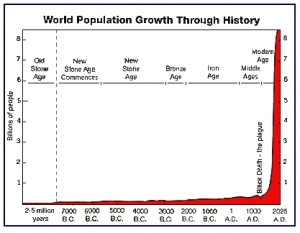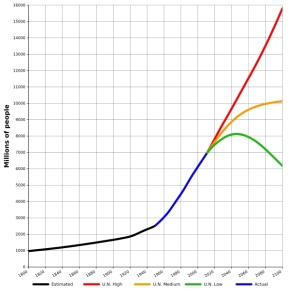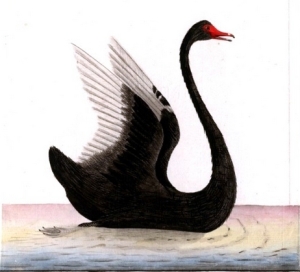 Black Swans and Civilisation Collapse
Black Swans and Civilisation Collapse
A really interesting branch of mathematics is involved in making future predictions about how civilisation will evolve in the future – and indeed looking at how robust our civilisation is to external shocks. This is one area in which mathematical models do not have a good record as it is incredibly difficult to accurately assign probabilities and form policy recommendations for events in the future.
Malthusian Catastrophe
One of the most famous uses of mathematical models in this context was by Thomas Malthus in 1798. He noted that the means of food production were a fundamental limiting factor on population growth – and that if population growth continued beyond the means of food production that there would be (what is now termed) a “Malthusian catastrophe” of a rapid population crash.
As it turns out, agrarian productivity has been able to keep pace with the rapid population growth of the past 200 years.
Looking at the graph we can see that whilst it took approximately 120 years for the population to double from 1 billion to 2 billion, it only took 55 years to double again. It would be a nice exercise to try and see what equation fits this graph – and also look at the rate of change of population (is it now slowing down?) The three lines at the end of the graph are the three different UN predictions – high end, medium and low end estimate. There’s a pretty stark difference between high end and low end estimates by 2100 – between 16 billion and 6 billion! So what does that tell us about the accuracy of such predictions?
Complex Civilisations
More recently academics like Joseph Tainter and Jared Diamond have popularised the notion of civilisations as vulnerable to collapse due to ever increasing complexity. In terms of robustness of civilisation one can look at an agrarian subsistence example. Agrarian subsistence is pretty robust against civilisation collapse – small self sufficient units may themselves be rather vulnerable to famines and droughts on an individual level, but as a society they are able to ride out most catastrophes intact.
The next level up from agrarian subsistence is a more organised collective – around a central authority which is able to (say) provide irrigation technology through a system of waterways. Immediately the complexity of society has increased, but the benefits of irrigation allow much more crops to be grown and thus the society can support a larger population. However, this complexity comes at a cost – society now is reliant on those irrigation channels – and any damage to them could be catastrophic to society as a whole.
To fast forward to today, we have now an incredibly complex society, far far removed from our agrarian past – and whilst that means we have an unimaginably better quality of life, it also means society is more vulnerable to collapse than ever before. To take the example of a Coronal Mass Ejection – in which massive solar discharges hit the Earth. The last large one to hit the Earth was in 1859 but did negligible damage as this was prior to the electrical age. Were the same event to happen today, it would cause huge damage – as we are reliant on electricity for everything from lighting to communication to refrigeration to water supplies. A week without electricity for an urban centre would mean no food, no water, no lighting, no communication and pretty much the entire breakdown of society.
That’s not to say that such an event will happen in our lifetimes – but it does raise an interesting question about intelligent life – if advanced civilisations continue to evolve and in the process grow more and more complex then is this a universal limiting factor on progress? Does ever increasing complexity leave civilisations so vulnerable to catastrophic events that their probabilities of surviving through them grow ever smaller?
Black Swan Events
One of the great challenges for mathematical modelling is therefore trying to assign probabilities for these “Black Swan” events. The term was coined by economist Nassim Taleb – and used to describe rare, low probability events which have very large consequences. If the probability of a very large scale asteroid impact is (say) estimated as 1-100,000 years – but were it to hit it is estimated to cause $35 trillion of damage (half the global GDP) then what is the rational response to such a threat? Dividing the numbers suggests that we should in such a scenario be spending $3.5billion every year on trying to address such an event – and yet which politician would justify such spending on an event that might not happen for another 100,000 years?
I suppose you would have to conclude therefore that our mathematical models are pretty poor at predicting future events, modelling population growth or dictating future and current policy. Which stands in stark contrast to their abilities in modelling the real world (minus the humans). Will this improve in the future, or are we destined to never really be able to predict the complex outcomes of a complex world?
If you enjoyed this post you might also like:
Asteroid Impact Simulation – which allows you to model the consequences of asteroid impacts on Earth.
Chaos Theory – an Unpredictable Universe? – which discusses the difficulties in mathematical modelling when small changes in initial states can have very large consequences.
Essential resources for IB students:
1) Exploration Guides and Paper 3 Resources

I’ve put together four comprehensive pdf guides to help students prepare for their exploration coursework and Paper 3 investigations. The exploration guides talk through the marking criteria, common student mistakes, excellent ideas for explorations, technology advice, modeling methods and a variety of statistical techniques with detailed explanations. I’ve also made 17 full investigation questions which are also excellent starting points for explorations. The Exploration Guides can be downloaded here and the Paper 3 Questions can be downloaded here.


You said that this was difficult to write an equation for, but even so do you think it would be a high- scoring IA? Im very interested in this topic.
yes – you could definitely do a good IA on this topic. It could be similar to some of the older IA investigations the IB used to set (such as population growth in China). For these ones you needed to try and fit a function to data points to see which function most closely described the trend.
Currently, there are not a real teorhy to forecast the black swans events.
can you